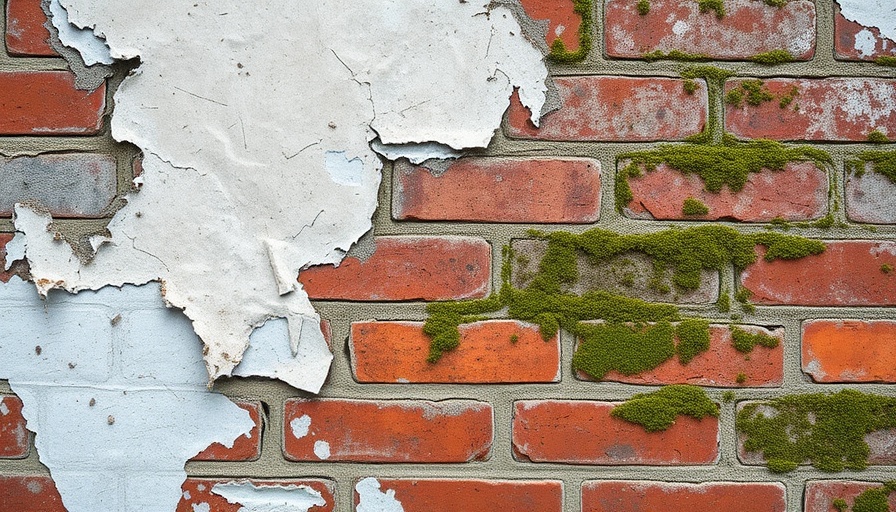
Understanding the Risks of Moisture Damage in Brick Homes
As urban living becomes increasingly prevalent, understanding the dynamics of maintaining brick homes is essential for homeowners looking for longevity and structural integrity. Moisture damage doesn’t just hamper aesthetic appeal; it can lead to structural failure, making it critical to recognize what causes such deterioration. Water can seep into bricks and mortar, facilitated by various factors including heavy rains, poor drainage, and high humidity levels.
Signs of moisture damage manifest in peeling paint, damp patches on walls, and unpleasant odors. In severe cases, homeowners may find efflorescence—white, powdery salt deposits—on exterior surfaces. Being familiar with these indicators allows you to act proactively. Homeowners can seek professional assessments, like those offered by services such as D’Angelo Brick Repair, ensuring timely interventions to secure their homes.
Proactive Assessment: Identify Vulnerable Areas
Conducting regular inspections of both the interior and exterior of your brick home is paramount in preventing moisture damage. Begin your check-ups by examining the exterior for any visible cracks in the brickwork. Pay attention to the alignment of gutters and downspouts; misalignments can cause water to cascade onto brick surfaces, exacerbating potential issues.
Inside, focus on high-risk areas like basements and locations near plumbing pipes. Look for signs of moisture accumulation, such as mold or peeling paint—these could signal underlying problems that need immediate attention. Aim to perform these checks at least biannually, or more frequently during the rainy season. Identifying issues early on can save homeowners from extensive repairs down the line.
Implementing Protective Measures: Water-Repellent Techniques
Once vulnerabilities are assessed, homeowners can take effective measures to protect their brick structures. Water-repellent techniques are critical and can range from simple sealants to more robust waterproof coatings. Applied correctly, sealants can block moisture from penetrating inside, significantly reducing the risk of damage.
Waterproof coatings are especially beneficial as they permit the escape of internal moisture while keeping rainwater at bay. Materials consisting of elastomeric compounds serve as durable barriers, supporting the overall health of your brick structure. The dual action of these products preserves appearance and structural integrity, making them invaluable for homeowners.
Ensuring Effective Drainage: A Key to Moisture Management
Proper drainage is paramount in keeping moisture away from your brick home. First, inspect your gutters and downspouts to ensure they direct water away from your foundation effectively. It's essential that the grading around your home slopes away from the structure to facilitate water runoff.
Keep gutters clear of debris and consider replacing any outdated installations. An efficient drainage system serves as the first line of defense against moisture intrusion, hence regular cleaning and maintenance should not be overlooked.
Future Insights: Sustainable Solutions for Brick Moisture Management
As sustainable living continues to gain traction, many homeowners are exploring green solutions for maintaining their brick structures. For instance, incorporating landscaping practices that utilize drought-resistant plants can reduce the amount of water runoff towards your home.
Urban gardening initiatives encourage homeowners to think beyond traditional methods of maintenance, implementing eco-friendly practices that complement their brick homes. Creating garden beds with proper grading can help, as well as leveraging rain gardens to manage excessive water flow naturally. These sustainable approaches not only enhance your home’s aesthetics but also contribute positively to the environment.
Making Actionable Choices for Your Brick Home
Engaging with local experts and participating in community workshops can provide greater insights into effective moisture management strategies. Homeowners can form alliances with neighbors to share revolving resources for inspections and maintenance—this communal aspect can lead to greater awareness and proactive management of moisture risks.
Moving forward, adopting a mindset of vigilance and proactivity will empower homeowners, not only safeguarding their investments but also cultivating a deeper appreciation for the architecture that surrounds them. Implementing these practical solutions will lead to a sustainable living environment that harmonizes functionality and aesthetic charm.
For those keen on the sustainable management of home environments and urban spaces, exploring topics in urban farming or community gardening can enhance resilience against such common household dilemmas. Understanding moisture dynamics is only a part of the broader goal of fostering a self-sustaining lifestyle.
By adopting best practices, homeowners contribute positively to their living spaces and, by extension, to the communities they inhabit. Taking action now gives the privilege of enjoying a safe and warm home today, while ensuring legacy for the future generations.
 Add Row
Add Row  Add
Add 




 Add Row
Add Row  Add
Add 

Write A Comment